Author: Babywhale, Techub News
When everyone thought that the U.S. Securities and Exchange Commission had approved the Bitcoin spot ETF, and a scene reminiscent of the "all coins rise" of 2021 would reappear, reality delivered a heavy blow: aside from Bitcoin aiming for $100,000, many "altcoins" that shone brightly in the last bull market not only failed to reach new highs in this cycle but are still hovering at the bottom.
To some extent, this may also indicate that as cryptocurrency investment gradually becomes mainstream in the U.S., new incoming funds will concentrate on high-quality targets, much like in the U.S. stock market. In this cycle, some tokens that reached peaks in the last bull market have once again become favorites of profit-seekers. I have compiled a list of some tokens that set phase highs during the 2021 bull market and have reached new highs in this cycle, but my understanding is limited, and I may not cover all tokens that fit this situation.
SOL

In the hot "Alt L1" of 2021, EVM-compatible L1s like Fantom, NEAR, and Avalanche absorbed the overflow traffic due to high Ethereum gas costs. Among them, Solana did not follow the trend but instead established its own ecosystem outside of EVM. With the support of FTX founder SBF, who was at the peak of his power at the time, and the team's operations, the price of SOL skyrocketed from less than $1 when it first listed on exchanges to over $200.
However, as the overall market transitioned from frenzy to calm, coupled with the collapse of FTX and the imprisonment of one of Solana's biggest supporters, SBF, SOL fell to a low of around $7. Many well-known NFT projects on Solana left, and many investors believed that Solana's story might be over.
Unexpectedly for these individuals, during this cycle, Solana revived with the rise of memes and several ecological projects, such as the re-staking project Jito. The price of SOL rose sharply and recently broke through the nearly $260 high set in early November 2021.
BNB

As the only public chain among "exchange platform tokens" that has truly diversified its ecosystem, Binance's BNB has left a deep impression both in the bear market for its "resilience" and in the bull market for its rise. In the bear market of 2022, BNB fell from its peak of around $660 in May 2021 to below $200 at one point. Although the decline was significant, compared to many tokens that fell over 90% or nearly to zero, BNB can be considered a relatively "high-value" asset.
Subsequently, with the market's recovery and Binance launching Launchpool and Launchpad projects at an almost frenzied pace, BNB surged and broke through the previous bull market price peak on June 24 this year, reaching over $700. In contrast to the quiet exit of Huobi's HECO Network, BNB still has a lot of potential value to be further explored both within the exchange and on the BNB Chain.
TRX

The new high of Tron token TRX in this cycle can be seen as both unexpected and expected. The issuance of USDT has approached 140 billion, and Tron has been the preferred choice for USDT transfers for a long time. Although Tron has been surpassed by Ethereum in USDT issuance and is clearly inferior to Ethereum in practical application scenarios, it must be acknowledged that at least in terms of capital flow, Tron remains the top choice for USDT holders.
According to DefiLlama data, as of the writing of this article, the TVL on Tron is approximately $7.555 billion, having once exceeded $10 billion in March this year. The price of TRX reached a high of $0.18 on April 17, 2021, and two weeks ago, on November 12, TRX set a new high, rising to over $0.22 in the following days.
TON
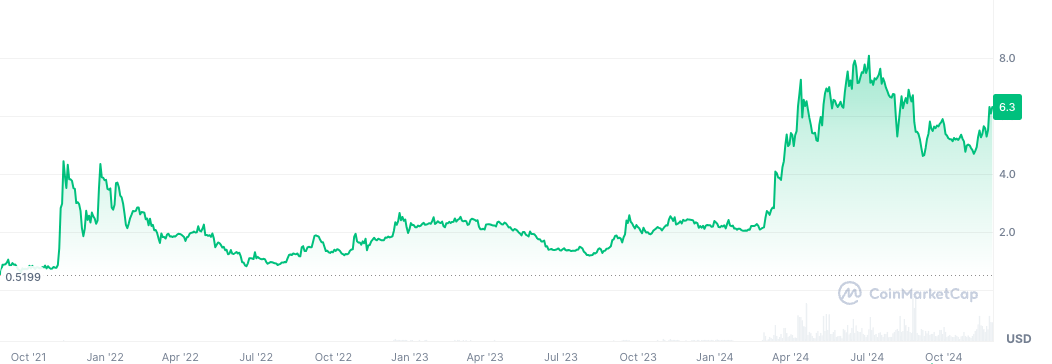
The emergence of TON dates back to the ICO era, when Telegram raised $1.7 billion through an ICO for its token Grams and planned to launch The Open Network (TON). However, a lawsuit from the SEC put everything on hold. This typical SEC lawsuit, which treated everything as a security, was finally settled in 2020, and Telegram paid the price of being unable to continue the development of TON.
Afterward, TON continued to operate with community support but never made significant waves in the industry. Its token price fell continuously after reaching a high of $4.4 at the end of 2021.
Fast forward to 2022, during the months from April to July, the TON Foundation, along with several institutions, frequently launched ecological funds worth tens of millions or even hundreds of millions of dollars, signaling the rapid expansion of the TON ecosystem. As a blockchain under Telegram, which has tens of millions of users, TON did not focus too much on user numbers. The various games it launched and the interactive experiences integrated with Telegram made its process from 0 to 1 very smooth, and the speed from 1 to 100 was astonishing.
With the market's enthusiasm, TON's price briefly surpassed $8 in June this year, nearly doubling from its previous "peak."
LEO
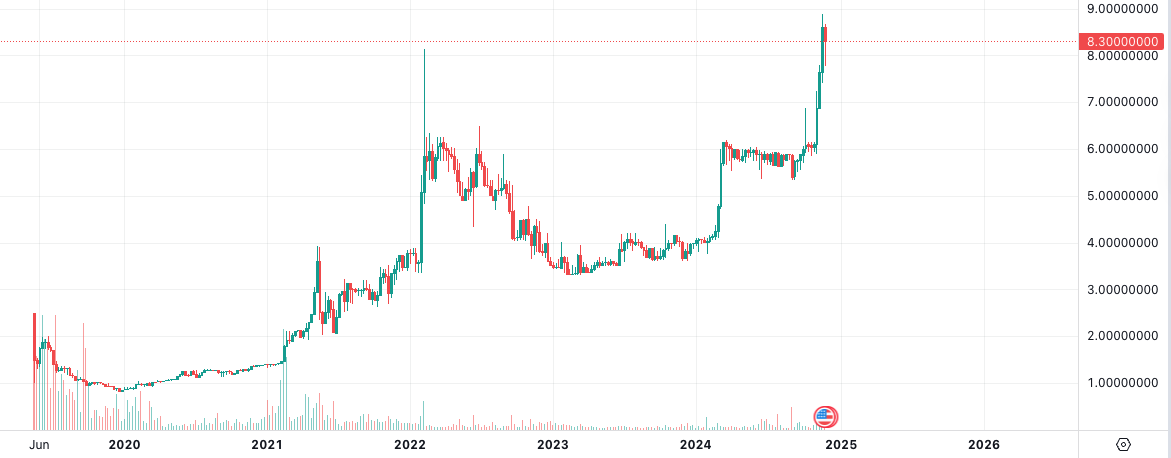
To be honest, if I hadn't checked the data site, I wouldn't have known about the existence of this token. LEO is a token issued by the well-established exchange Bitfinex, serving purposes such as fee reductions. I couldn't find any convincing news on why this token reached a new high; the only possibility is that the sentencing of the hacker who stole 120,000 bitcoins from Bitfinex might be seen as a positive development to some extent.
LEO briefly surpassed $8 in early February 2022, and on November 20, a week ago, LEO set a new high, rising to nearly $9.
FET
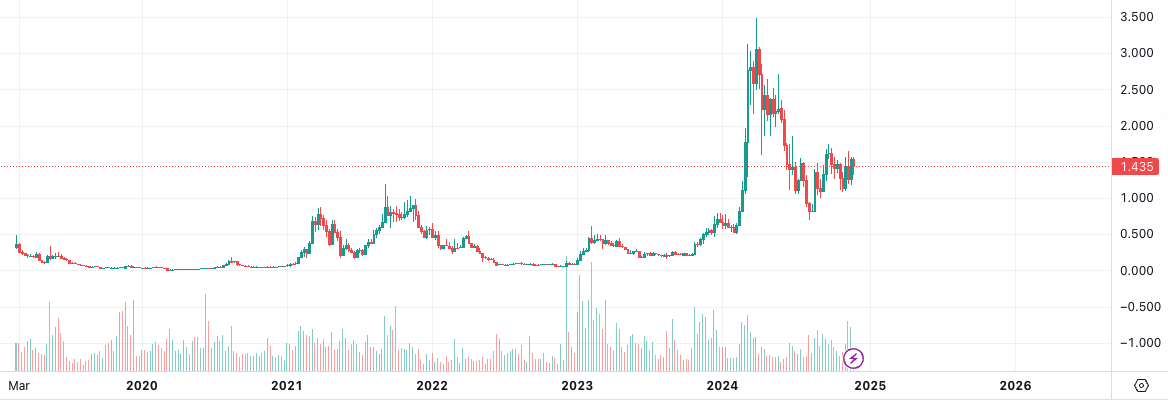
Fetch.ai, born before the last bull market, has managed to survive until AI became the "hot topic" today. In the early days when the "blockchain +" concept was popular, many related projects were established, but most have since become historical dust. However, some projects, including Fetch.ai and IoTeX, have persevered and welcomed a true second spring.
In the first half of this year, SingularityNET, Fetch.ai, and Ocean Protocol proposed to establish a super artificial intelligence alliance and merge their tokens, a plan that has now been completed. The significant impact of AI on human societal development is undeniable, but whether Crypto can truly drive this process still requires time for observation.
In early September 2021, FET reached a phase high of nearly $1.20, and this year, the AI wave led by OpenAI brought FET's price to around $3.50, nearly doubling from the previous bull market high.
OKB
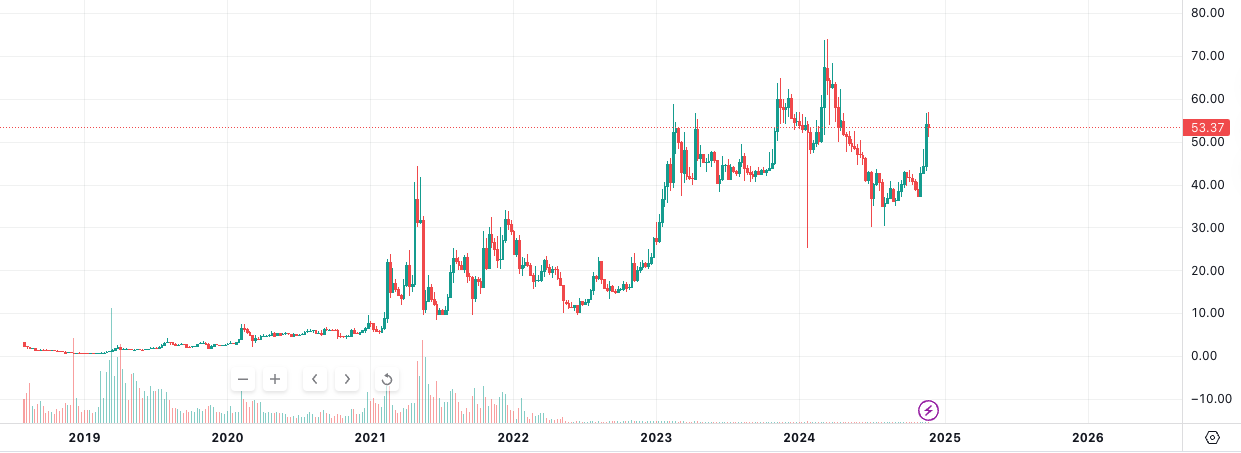
As one of the three giants of domestic exchanges in the past, OKX has performed impressively in the past two years. On one hand, OKX has made a series of optimizations in trading-related functions and user experience, allowing traders to personalize their trading plans more. This has led other exchanges to follow suit; on the other hand, the Web3 wallet launched by OKX may already be considered a phenomenon, becoming the top choice for many treasure hunters during the peak of inscriptions.
As for the price of OKB, it actually set a historical high early last year, coinciding with the timing of OKX's major reforms. In March this year, OKB reached a historical high of nearly $74, over 70% higher than the peak of around $44 in early May 2021.
STX
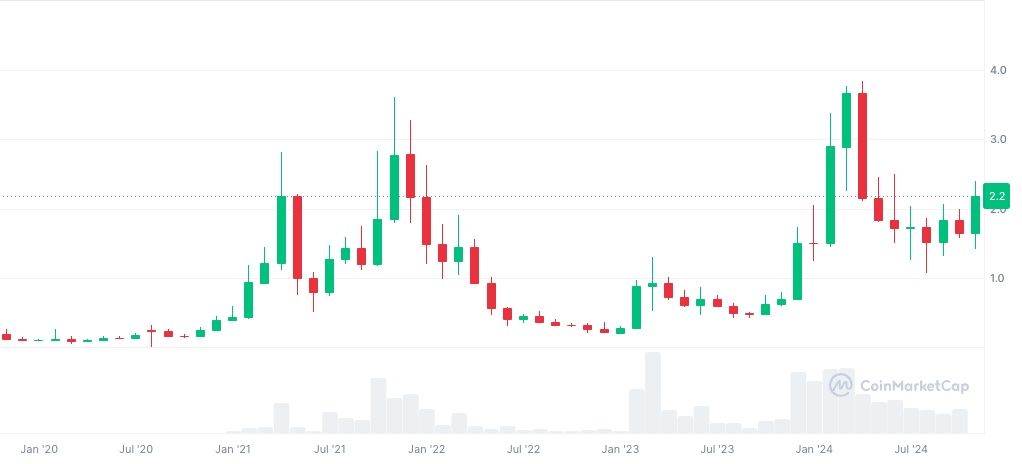
It must be noted that some projects whose token prices reached new highs in this cycle were not the darlings of the last bull market but had existed for many years and "found their kindred spirits" in this cycle.
Stacks can be considered an early attempt in Web3 to establish a smart contract platform utilizing the Bitcoin network. Its design is quite interesting; simply put, Bitcoin holders bid with their Bitcoin to earn block rewards and transaction fees for new Stacks blocks, while the packaging of the blocks is done by STX stakers. Once the block is added to the blockchain, they can retrieve the Bitcoin they used for bidding. Since it also uploads state information to the Bitcoin network to achieve finality, Stacks is regarded as a kind of "Bitcoin L2" to some extent.
The recent trend driven by inscriptions has revitalized this project, which has been cultivating the Bitcoin ecosystem for many years. The price of STX surged to around $3.85 in April this year, surpassing the previous phase high of about $3.6 set in November 2021.
INJ
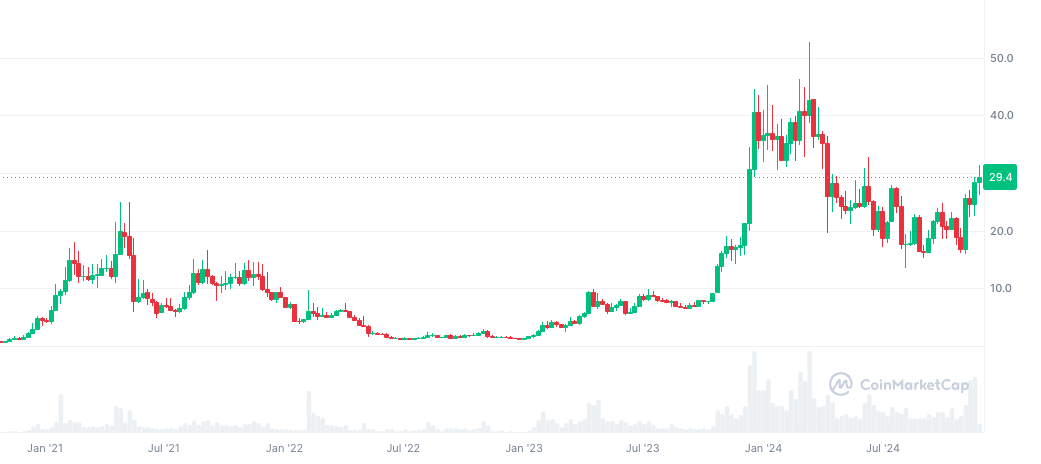
The Cosmos ecosystem is undoubtedly an indelible shadow in the minds of many investors. Like Polkadot, it possesses a unique style and technical strength in the cross-chain field but has not sparked a trend similar to DeFi. According to token price information websites, Injective was also a project born before the last bull market, but it may not have gained widespread recognition until it secured $40 million in funding in August 2022.
From the perspective of investors and participants in its launched ecological fund, including market makers and hedge funds, Injective seems to aim to establish a DeFi liquidity center. This plan is not unique, and on the surface, it may not appear particularly special, but the price of INJ has been on the rise. In mid-March this year, the price of INJ exceeded $52, more than doubling from the phase high of around $25 in April 2021.
BGB
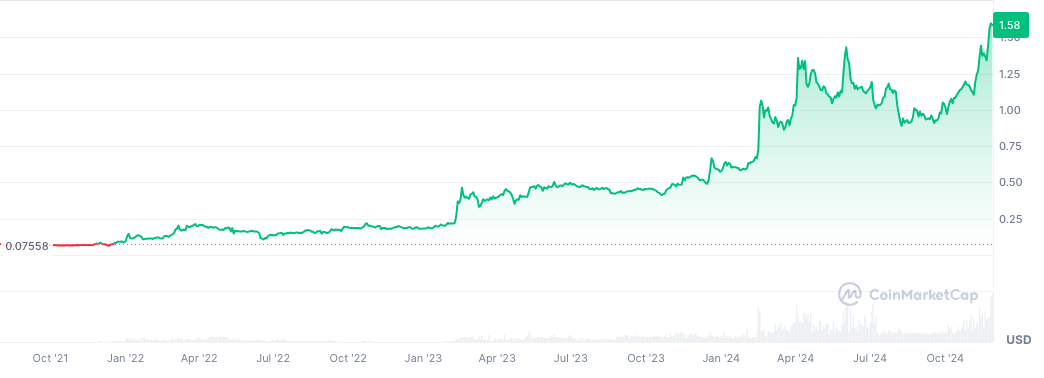
If the price increases of BNB and OKB are "expected," then the emergence of Bitget must have been beyond most people's expectations. From my perspective, it is hard to imagine that new players can still carve out a niche in the already crowded exchange field, but Bitget has indeed achieved this. With aggressive market strategies, a crazy yet efficient culture, wallet products, and various investment assistance, Bitget must have designed a comprehensive plan long before officially launching its market competition, perfectly seizing the residual heat from the last bull market and the opportunity presented by a new influx of users into Web3.
In contrast to the previously mentioned tokens that reached new highs after following the market downtrend, BGB has been in a climbing phase since its inception in 2021 and recently set a high point of $1.7.
免责声明:本文章仅代表作者个人观点,不代表本平台的立场和观点。本文章仅供信息分享,不构成对任何人的任何投资建议。用户与作者之间的任何争议,与本平台无关。如网页中刊载的文章或图片涉及侵权,请提供相关的权利证明和身份证明发送邮件到support@aicoin.com,本平台相关工作人员将会进行核查。




